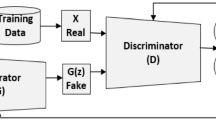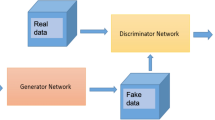Abstract
As an essential tool in security, the intrusion detection system bears the responsibility of the defense to network attacks performed by malicious traffic. Nowadays, with the help of machine learning algorithms, intrusion detection systems develop rapidly. However, the robustness of this system is questionable when it faces adversarial attacks. For the robustness of detection systems, more potential attack approaches are under research. In this paper, a framework of the generative adversarial networks, called IDSGAN, is proposed to generate the adversarial malicious traffic records aiming to attack intrusion detection systems by deceiving and evading the detection. Given that the internal structure and parameters of the detection system are unknown to attackers, the adversarial attack examples perform the black-box attacks against the detection system. IDSGAN leverages a generator to transform original malicious traffic records into adversarial malicious ones. A discriminator classifies traffic examples and dynamically learns the real-time black-box detection system. More significantly, the restricted modification mechanism is designed for the adversarial generation to preserve original attack functionalities of adversarial traffic records. The effectiveness of the model is indicated by attacking multiple algorithm-based detection models with different attack categories. The robustness is verified by changing the number of the modified features. A comparative experiment with adversarial attack baselines demonstrates the superiority of our model.
Z. Lin—This work was done when the author was at Shanghai Jiao Tong University.
Access this chapter
Tax calculation will be finalised at checkout
Purchases are for personal use only
Similar content being viewed by others
References
Arjovsky, M., Chintala, S., Bottou, L.: Wasserstein generative adversarial networks. In: International Conference on Machine Learning, pp. 214–223. PMLR (2017)
Carlini, N., Wagner, D.: Adversarial examples are not easily detected: bypassing ten detection methods. In: Proceedings of the 10th ACM Workshop on Artificial Intelligence and Security, pp. 3–14. ACM, Dallas, TX, USA (2017)
Goodfellow, I., et al.: Generative adversarial nets. In: Advances in Neural Information Processing Systems, pp. 2672–2680 (2014)
Hitaj, B., Gasti, P., Ateniese, G., Perez-Cruz, F.: PassGAN: a deep learning approach for password guessing. In: Deng, R.H., Gauthier-Umaña, V., Ochoa, M., Yung, M. (eds.) ACNS 2019. LNCS, vol. 11464, pp. 217–237. Springer, Cham (2019). https://doi.org/10.1007/978-3-030-21568-2_11
Hu, W., Tan, Y.: Generating adversarial malware examples for black-box attacks based on gan. arXiv:1702.05983 (2017)
Ingre, B., Yadav, A., Soni, A.K.: Decision tree based intrusion detection system for NSL-KDD dataset. In: Satapathy, S.C., Joshi, A. (eds.) ICTIS 2017. SIST, vol. 84, pp. 207–218. Springer, Cham (2018). https://doi.org/10.1007/978-3-319-63645-0_23
Li, Z., Qin, Z., Huang, K., Yang, X., Ye, S.: Intrusion detection using convolutional neural networks for representation learning. In: Liu, D., Xie, S., Li, Y., Zhao, D., El-Alfy, E.-S.M. (eds.) ICONIP 2017. LNCS, vol. 10638, pp. 858–866. Springer, Cham (2017). https://doi.org/10.1007/978-3-319-70139-4_87
Pacheco, Y., Sun, W.: Adversarial machine learning: a comparative study on contemporary intrusion detection datasets. In: ICISSP, pp. 160–171 (2021)
Pasquini, D., Gangwal, A., Ateniese, G., Bernaschi, M., Conti, M.: Improving password guessing via representation learning. In: 2021 IEEE Symposium on Security and Privacy (SP), pp. 1382–1399. IEEE (2021)
Rigaki, M.: Adversarial deep learning against intrusion detection classifiers (2017)
Sapre, S., Ahmadi, P., Islam, K.: A robust comparison of the kddcup99 and NSL-KDD IoT network intrusion detection datasets through various machine learning algorithms. arXiv:1912.13204 (2019)
Shetty, R., Schiele, B., Fritz, M.: A4nt: author attribute anonymity by adversarial training of neural machine translation. In: 27th USENIX Security Symposium (USENIX Security 2018), pp. 1633–1650 (2018)
Tsai, C.F., Hsu, Y.F., Lin, C.Y., Lin, W.Y.: Intrusion detection by machine learning: a review. Expert Syst. Appl. 36(10), 11994–12000 (2009)
Wang, Z.: Deep learning-based intrusion detection with adversaries. IEEE Access 6, 38367–38384 (2018)
Yang, K., Liu, J., Zhang, C., Fang, Y.: Adversarial examples against the deep learning based network intrusion detection systems. In: MILCOM 2018–2018 IEEE Military Communications Conference (MILCOM), pp. 559–564. IEEE (2018)
Author information
Authors and Affiliations
Corresponding author
Editor information
Editors and Affiliations
Rights and permissions
Copyright information
© 2022 The Author(s), under exclusive license to Springer Nature Switzerland AG
About this paper
Cite this paper
Lin, Z., Shi, Y., Xue, Z. (2022). IDSGAN: Generative Adversarial Networks for Attack Generation Against Intrusion Detection. In: Gama, J., Li, T., Yu, Y., Chen, E., Zheng, Y., Teng, F. (eds) Advances in Knowledge Discovery and Data Mining. PAKDD 2022. Lecture Notes in Computer Science(), vol 13282. Springer, Cham. https://doi.org/10.1007/978-3-031-05981-0_7
Download citation
DOI: https://doi.org/10.1007/978-3-031-05981-0_7
Published:
Publisher Name: Springer, Cham
Print ISBN: 978-3-031-05980-3
Online ISBN: 978-3-031-05981-0
eBook Packages: Computer ScienceComputer Science (R0)




